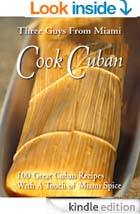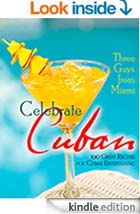Jorge Castillo: The sauce is called "chimichurri" and it is used on many types of Cuban and Argentine style steaks. Our Nicaraguan in-laws love it.
Raúl Musibay: We've also seen it served at the table in many restaurants with a fresh loaf of Cuban bread for dipping. Delicious!
Glenn Lindgren: I'll never forget the time I brought some chimichurri to a Minnesota barbeque. It was one of those "bring your own steak and a side dish to share parties." When I put the chimichurri on my steak hot off the grill, I got a lot of weird stares and comments. "Wow, what's that green stuff?" I persuaded a few people to try a little with their steaks, and the rest -- as they say -- is history. I soon had an empty bowl of chimichurri and everybody at the party was enjoying a new taste sensation!
Raúl Musibay: It happens all the time. Some people just have convinced themselves that they're not going to like a certain type of food. Once they try it -- wow -- they love it!
Glenn Lindgren: The typical Argentine version of chimichurri is made with parsley. In our "Cubanized" version, we use cilantro instead -- it gives it a great flavor, much more intense than the regular variety.
Chimichurri Sauce -- Garlic Citrus Sauce for Meat
By
Prep time: 15 minutesTotal time: 15 minutes
Yield: Enough for 4 steaks
Our "Cubanized" version of this Argentinean sauce, uses cilantro instead of parsley.
INGREDIENTS:
1 large bunch cilantro leaves8 cloves garlic
1/4 cup vinegar
1 lime (Juice only)
2/3 cup olive oil
1/2 cup onion
Dash or two red pepper flakes
salt and pepper to taste
Optional additions:
1/2 cup sweet red peppers chopped1/2 cup minced tomato
1/2 cup fresh oregano,chopped
Add salt, pepper, more vinegar and lime juice as needed. The flavor should be very intense with garlic and cilantro. Don't be stingy with the salt either!
Several restaurants add to the dish by adding some (or all) of the optional additions. However, we like it just fine without the additions. See what you like -- experiment!
OUR COOKBOOKS ARE NOW AVAILABLE AS KINDLE EBOOKS!
This new Kindle version contains all of the recipes and editorial copy from the original print edition. As a bonus, the new Kindle edition includes 14 new photos of the prepared dishes.
No Kindle?
Use the FREE Kindle Reading App and view our cookbooks on your notepad, tablet, laptop, or computer.
- 7 garlic cloves
- 3/4 cup olive oil
- 3 1/2 tablespoons Spanish sweet paprika
- 2 tablespoons dry oregano
- 2 tablespoons chopped parsley
- 3 tablespoons white vinegar
- 3 1/2 tablespoons crushed red pepper
- Salt to taste
- 3/4 cup olive oil
Place all ingredients except oil in food processor and using the "chop" setting, pulse on and off until you have a thick mixture. Do not over process!
Whisk in the olive oil. (If you use the blender to incorporate the oil, the oil and liquids will emulsify, giving your chimichurri a white, paste-like texture.) Taste it and add salt as needed to finish.
Three Guys From Miami Show You How to Make the Best Cuban, Spanish, and Latin American Food!
Drinks | Appetizers | Salads | Main Dishes| Soups | Side Dishes | Desserts | Index

Visit All of Our Sites:
Three Guys From Miami:
Cuban, Spanish, and Latin American food recipes, Miami/Little Havana Travel Guide, Miami Restaurant Guide, Hispanic Culture & Food
The Three Guys From Miami are: Raúl Musibay, Glenn Lindgren, and Jorge Castillo
Check out The Three Guys From Miami's Google+ Fan Page
No copying or commercial duplication of any content (including photos) without the express written permission of the authors and proper attribution.





